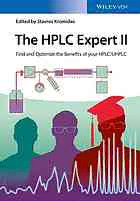
The HPLC Expert II: Find and Optimize the Benefits of HPLC/UHPLC PDF
Preview The HPLC Expert II: Find and Optimize the Benefits of HPLC/UHPLC
TheHPLCExpertII The HPLC Expert II FindandOptimizetheBenefitsofyourHPLC/UHPLC EditedbyStavrosKromidas Editor AllbookspublishedbyWiley-VCHare carefullyproduced.Nevertheless,authors, Dr.StavrosKromidas editors,andpublisherdonotwarrantthe Consultant,Saarbrücken informationcontainedinthesebooks, BreslauerStr.3 includingthisbook,tobefreeoferrors. 66440Blieskastel Readersareadvisedtokeepinmindthat Germany statements,data,illustrations,procedural detailsorotheritemsmayinadvertently beinaccurate. LibraryofCongressCardNo.:appliedfor BritishLibraryCataloguing-in-Publication Data Acataloguerecordforthisbookisavail- ablefromtheBritishLibrary. Bibliographicinformationpublishedby theDeutscheNationalbibliothek DieDeutscheNationalbibliothek liststhispublicationintheDeutsche Nationalbibliografie;detailed bibliographicdataareavailableonthe Internetathttp://dnb.d-nb.de. ©2017Wiley-VCHVerlagGmbH&Co. KGaA,Boschstr.12,69469Weinheim, Germany Allrightsreserved(includingthoseof translationintootherlanguages).Nopart ofthisbookmaybereproducedinany form – byphotoprinting,microfilm,or anyothermeans – nortransmittedor translatedintoamachinelanguage withoutwrittenpermissionfromthe publishers.Registerednames,trademarks, etc.usedinthisbook,evenwhennot specificallymarkedassuch,arenottobe consideredunprotectedbylaw. PrintISBN:978-3-527-33972-3 ePDFISBN:978-3-527-69497-6 ePubISBN:978-3-527-69495-2 MobiISBN:978-3-527-69496-9 oBookISBN:978-3-527-69494-5 CoverDesign Formgeber,Mannheim, Germany Typesetting SPiGlobal,Chennai,India PrintingandBinding Printedonacid-freepaper v Contents ListofContributors xiii Foreword xv TheStructureof“TheHPLC-Expert2” xvii 1 WhenShouldIUseMyUHPLCasaUHPLC? 1 StavrosKromidas 1.1 Introduction 1 1.2 WhatDoIWanttoAchieveandWhatIsaUHPLCCapableof? 2 1.2.1 WhatDoIWanttoAchieve? 2 1.2.2 WhatIsaUHPLCCapableof? 2 1.3 WhatIsRequiredfromanHPLCMethod? 3 1.3.1 SeparateWell 3 1.3.2 SeparateFast 12 1.3.3 ImproveMassSensitivity 13 1.3.4 RobustSeparationsinRoutineUse 15 1.4 TheUHPLCinRoutineUse–ABriefReport 17 1.5 HowCanthePotentialofUHPLCEffectivelyBeFullyExploited? (SeeAlsoChapters2,3,and9) 20 1.5.1 DeadVolumes 20 1.6 SummaryandOutlook 22 1.6.1 Outlook 24 References 25 PartI HardwareandSoftware,SeparationModes, Materials 27 2 TheModernHPLC/UHPLCDevice 29 2.1 TheModernHPLC/UHPLCSystem 29 SteffenWieseandTerenceHetzel 2.1.1 Today’sDemandsontheIndividualModules 29 2.1.1.1 Overview 29 2.1.2 UHPLCPumpTechnology 30 2.1.2.1 High-andLow-PressurePumps 30 2.1.2.2 GradientDelayVolume 34 vi Contents 2.1.3 Autosampler 35 2.1.3.1 Fixed-LoopAutosamplers 36 2.1.3.2 Flow-ThroughAutosamplers 38 2.1.3.3 ReviewoftheAdvantagesandDisadvantagesofFixed-Loopand Flow-ThroughAutosamplers 40 2.1.4 ColumnOven 41 2.1.5 Detectors 44 2.1.6 CapillariesandFittings 47 Acknowledgment 50 References 50 2.2 TheThermostateofColumns–AMinorMatter 52 MichaelHeidornandFrankSteiner 2.2.1 ThermalModesofColumnThermostats 54 2.2.2 TemperatureDifferencesbetweenColumnandMobilePhase 57 2.2.3 FrictionalHeat–JustaPhenomenoninUHPLC? 62 2.2.4 ThermostaticControlinMethodTransfer,MethodSpeed-Up,and MethodDevelopment 68 Literature 71 3 TheIssueofExternalBandBroadeninginHPLC/UHPLC Devices 73 MonikaDittmann 3.1 Introduction 73 3.2 TheoreticalBackground 74 3.2.1 EfficiencyandResolutionofModernUHPLCColumns 74 3.2.2 EstimationofColumnPeakVolumes 76 3.3 ExtracolumnDispersionin(U)HPLCSystems 78 3.3.1 SourcesofExternalBandBroadeninginHPLC/UHPLCSystems 78 3.3.1.1 InjectionSystems 79 3.3.1.2 Tubing 80 3.3.1.3 FittingsandConnections 83 3.3.1.4 HeatExchangers 84 3.3.1.5 Detection 85 3.3.2 DeterminationofExternalBandBroadening 88 3.3.2.1 AnalysisofExtracolumnVolumewithoutColumn(ShortCircuit Method) 88 3.3.2.2 AnalysisofExtracolumnVolumeIncludingaColumn 89 3.4 ImpactofExternalContributionsinDifferentApplicationAreas 90 3.4.1 ImpactonIsocraticSeparations 90 3.4.2 ImpactonGradientSeparations 92 3.5 OptimizationofHPLC/UHPLCSystems 94 3.5.1 TestingofColumnPerformance 95 3.5.2 OtherIsocraticSeparations 95 3.5.3 High-ResolutionGradientSeparations 96 3.5.4 FastGradientSeparations 96 3.6 Conclusions 97 References 98 Contents vii 4 TheGradient;Requirements,OptimalUse,Hints,and Pitfalls 101 FrankSteiner 4.1 InstrumentalInfluencesinGradientElution–AnOverview 101 4.1.1 TheGradientDelayEffectandtheGradientDwellVolumeofa System 101 4.1.2 TheRoleandFunctionoftheGradientMixer 103 4.1.3 DeviationsfromIdealBehaviorofGradientGenerationResultingfrom FundamentalPhysicochemicalPhenomena 106 4.1.4 InstrumentalInfluencesonGradientElutionOutsidethePump 112 4.1.5 TheStressandWearonColumnsinGradientMethods 115 4.2 GradientElutionTechnologyandHowtoSystematicallyCharacterize GradientInstrumentation 117 4.2.1 PhysicochemicalEffectsofHighPressureonLiquids 117 4.2.2 TheNeedofSolventDegassing 120 4.2.3 TheDifferentTypesofPumpTechnology(Serial,Parallel,CamDrive, LinearDrive)andTheirSpecificPropertiesandRequirements 122 4.2.4 TheSpecificGradientPumpTypeandItsImplicationsforPractical Operation 125 4.2.5 HPGPumpsandHowDiscontinuousPumpCyclesResultingfrom PressurePulsationImpactRetentionTimePrecisioninPractice 127 4.2.6 LPGPumpsandHowTheirImmanentDiscontinuousGenerationof GradientCompositionMayImpactRetentionTimePrecisionin Practice 132 4.2.7 ThermalEffectsinGradientPumpsandHowIntelligentInstrument ControlCanMinimizetheConsequencesonChromatography 134 4.2.8 UltrafastMethodswithVerySteeporBallisticGradients 137 4.2.9 FundamentalConsiderationsontheDeterminationofaGradient DelayVolume 143 4.2.10 TheMarkerPulseMethodasaQuickWayforGDV Determination 145 4.2.11 TheDolanTestastheClassicalMethodforGDVOptimization 148 4.2.12 DesignsofMixersandTheirEffectivenessRelativetoTheirGDV Contribution 150 4.2.13 SystematicCharacterizationoftheMixingEfficiencyandGradient FormationofaPump 155 4.2.14 OptimizingtheMixingVolumeinDependenceofPumpTypeand FlowRateforDemandingApplicationsSuchasTFAGradients 162 4.2.15 ExceptionalElutionBehaviorofProteinswithMobile-PhaseMixing Ripples 168 References 169 5 RequirementsofLC-HardwarefortheCouplingofDifferent MassSpectrometers 171 TerenceHetzel,ThorstenTeutenberg,ChristophPortner,andJochenTuerk 5.1 Introduction 171 5.2 FromTargetAnalysistoScreeningApproaches 171 viii Contents 5.2.1 TargetAnalysis 171 5.2.2 Suspected-TargetScreening 172 5.2.3 NontargetScreening 172 5.3 WhatShouldBeConsideredforUHPLC/MSHyphenation? 173 5.3.1 TheInterfaceandtheOptimumFlowRate 173 5.3.2 OptimizationofMSParameters 174 5.3.3 OptimizationoftheChromatographicParameters 174 5.3.4 ChoiceoftheSuitableColumnandColumnDimension 176 5.4 TargetAnalysisUsingTriple-QuadrupoleMass Spectrometry 178 5.5 ScreeningApproachesUsingLC-MS 185 5.6 Miniaturization–LC-MSQuoVadis? 189 References 192 6 2Dchromatography–Opportunitiesandlimitations 193 ThorstenTeutenbergandJuriLeonhardt 6.1 Introduction 193 6.2 WhyTwo-DimensionalHPLC? 193 6.3 PeakCapacityofOne-andTwo-DimensionalLiquid Chromatography 195 6.3.1 PeakCapacityofOne-DimensionalLiquidChromatography 195 6.3.2 PeakCapacityofTwo-DimensionalLiquidChromatography 196 6.3.2.1 Heart-Cut2DLC(LC-LC) 196 6.3.2.2 Comprehensive2DLC(LC×LC) 197 6.4 Modulation 200 6.4.1 OnlineHeart-Cut2DLC 200 6.4.2 ComprehensiveOnline2DLC 200 6.4.3 Stop-FlowandOfflineLC×LC 202 6.5 PracticalProblemsofOnlineLC×LC 203 6.5.1 CompatibilityoftheSolventSystems 203 6.5.2 Dilution 203 6.5.3 HighFlowRate 203 6.5.4 CompatibilitywithMassSpectrometry 203 6.6 DevelopmentofaMiniaturizedLC×LCSystem 204 6.6.1 TechnicalPlatform 204 6.6.2 SelectionoftheStationaryPhase 204 6.6.3 SelectionoftheMobilePhaseandTemperature 205 6.6.4 ColumnDimensionandModulation 205 6.6.5 GradientProgrammingandOverallAnalysisTime 206 6.6.6 CouplingwithMassSpectrometry 206 6.7 RealApplications 207 6.7.1 MeasurementofaReferenceStandard 207 6.7.2 MeasurementofaRealSample 209 6.8 AdvantagesoftheMS/MSFunctionality 211 6.9 GeneralCommentstoSpecificAspectsofanLC×LCSystem 211 Contents ix 6.9.1 OfflineLC×LCversusOnlineLC×LC 211 6.9.2 Stop-FlowLC×LC 214 6.9.3 MultipleHeart-CutLC-LCandSelectedLC×LC(sLC×LC) 214 6.10 MethodDevelopmentandGradientProgramming 215 6.11 PresentationsoftheInstrumentManufacturers(inAlphabetical Order) 215 6.11.1 CommerciallyAvailableSolutionsforLC×LC 216 6.11.1.1 Agilent 216 6.11.1.2 Shimadzu 216 6.11.1.3 Thermo/Dionex 216 6.11.2 FurtherSystems 216 6.11.2.1 Sciex 216 6.11.2.2 Waters 216 6.12 2DLC–QuoVadis? 217 6.12.1 Software 217 6.12.2 SystemSetup 217 6.12.3 PeakversusPeakCapacity 218 References 219 7 MaterialsinHPLCandUHPLC–WhattoUseforWhich Purpose 223 TobiasFehrenbachandSteffenWiese 7.1 Introduction 223 7.2 RequirementsforMaterialsinUHPLC 225 7.2.1 MechanicalStability 225 7.2.2 ChemicalStability 225 7.2.3 AnalyteCompatibility/Biocompatibility 226 7.3 FlowPathsinUHPLCSystems 227 7.3.1 Low-PressureandHigh-PressureFlowPath 227 7.3.2 Mobile-PhaseandSampleFlowPath 228 7.4 Low-PressureFlowPath 229 7.5 High-PressureFlowPath 231 7.5.1 Pumps 231 7.5.1.1 InletandOutletValves 231 7.5.1.2 PumpHead 233 7.5.1.3 PumpPistonsandPistonSeals 236 7.5.1.4 PracticalAspects 237 7.5.2 Autosamplers 238 7.5.2.1 Materials 238 7.5.2.2 SampleNeedles,SampleVials,andClosures 238 7.5.2.3 InjectionValves 239 7.5.2.4 PracticalAspects 241 7.5.3 TubingandFittingSystems 242 7.5.3.1 Outline 242 7.5.3.2 Materials 243 x Contents 7.5.3.3 Tubing 244 7.5.3.4 FittingSystems 246 7.6 WhenandWhyCananInertUHPLCSystemBeRequired? 248 7.6.1 ConceptofInertness 248 7.6.1.1 GeneralInertness 248 7.6.1.2 Analyte-SpecificInertness 249 7.6.2 NatureofthePassiveLayer 249 7.6.2.1 PassiveLayersofChromiumAlloys 251 7.6.2.2 PassiveLayersofTitaniumAlloys 252 7.6.3 RequirementsandInteractions 253 7.6.3.1 MechanicalandPhysicalIntegrityoftheUHPLCSystem 253 7.6.3.2 RequirementoftheDetectionMethod 254 7.6.3.3 InteractionofAnalyteandUHPLCSystem 254 7.6.4 PassivationStrategiesandMethods 258 References 261 PartII ExperienceReports,Trends 269 8 WhataSoftwarehastoPossessinOrdertoUsetheHardware Optimally 271 ArnoSimon 8.1 FunctionalityandHandling 271 8.1.1 Integration 272 8.1.2 InstrumentControl 273 8.1.3 Useability 274 8.1.4 EaseofUse 274 8.1.5 UserInterface 275 8.1.6 Multilingual 276 8.2 DataExchange 277 8.2.1 ImportandExportofData 278 8.3 FromPCsScalabilitytoGlobalInstallation 278 8.3.1 SoftwarePlacement 278 9 AspectsoftheModernHPLCDevice–ExperienceReportofan Operator 281 SteffenWieseandTerenceHetzel 9.1 Introduction 281 9.2 DeterminationoftheGradientDelayVolume 281 9.3 High-ThroughputSeparations 285 9.4 MethodTransferbetweenUHPLCSystemsofDifferent Manufacturers 287 9.5 ApplicationofElevatedTemperatures 290 9.6 Large-VolumeInjection(LVI) 293 9.7 UHPLCSeparationwith1mmIDColumns 296 Acknowledgment 299 References 299 Contents xi 10 ExperiencesofanIndependentServiceEngineer–Hintsand RecommendationsforanOptimalOperationofAgilentand Waters-Devices 301 SiegfriedChroustovsky 10.1 Introduction 301 10.2 TheDegasser,Principles 301 10.2.1 DifferentManufacturers,DifferentConcepts 302 10.3 ThePump,Principles 303 10.3.1 DifferentManufacturers,DifferentConcepts 305 10.4 TheAutosampler,Principles 306 10.4.1 DifferentManufacturers,DifferentConcepts 307 10.5 TheUVDetector,Principles 308 10.5.1 DifferentManufacturers,DifferentConcepts 309 11 TheAnalyte,theQuestion,andtheUHPLC–TheUseofUHPLC inPractice 311 StefanLamotte 11.1 Introduction 311 11.2 WhenDoesItMakeSensetoUseUHPLCandWhenShouldIBetter UseConventionalHPLC? 311 11.3 DissolutionTestsinPharmaceuticalIndustry 313 11.4 MethodDevelopmentandOptimization 314 11.5 Typical“Classical”LiquidChromatographic Analysis 314 11.6 Fast(MostSecond)DimensionofMultidimensional Chromatography 315 11.7 Separationof(Bio)polymers 316 11.8 ProcessAnalysis(PAT) 316 11.9 Conclusion 316 References 316 12 ReportofDeviceManufacturers–ArticlebyAgilent,Shimadzu, andThermoScientific 319 12.1 AgilentTechnologies 319 JensTrafkowski References 328 12.2 HPLCCurrentStatusandFutureDevelopment 328 Björn-ThoralfErxleben 12.3 ThermoFisherScientific,Germering 334 FrankSteiner 12.3.1 TotalSystemRequirementsandRelatedKeyExperiences 334 12.3.1.1 NanoLC 335 12.3.1.2 HPLCandUHPLConTwoInstrumentalPlatforms(UltiMate3000, Vanquish) 336 12.3.1.3 Viper-BasedSystemTubing 338 12.3.2 TheContributionoftheIndividualComponentstotheSuccessofa System 338
